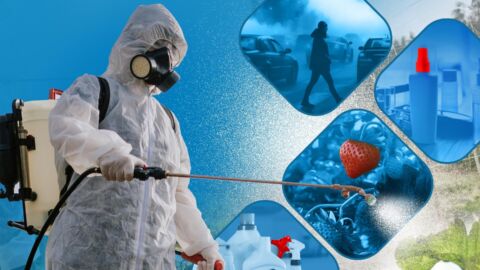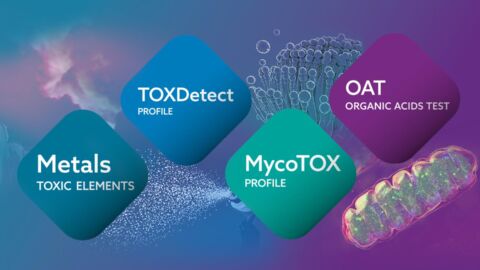Volatile organic compounds (VOCs) are common environmental toxicants from fuels, solvents, building materials, and consumer products. Many are lipophilic and require Phase I/II biotransformation to become water-soluble for elimination leaving urinary metabolites that make otherwise “invisible” exposures clinically measurable. Mosaic Diagnostics’ How the Body Metabolizes Environmental Toxicants” offers a guide to how major environmental VOCs are metabolized in the human body. By mapping parent VOCs to their urinary metabolites and highlighting key clinical insights, it serves as a valuable tool for assessing possible exposures and supporting clinical decision-making at the point of care.
Study spotlight: new evidence connecting toxicants to mortality (Fang et al., Environmental Pollution, 2025)
ICYMI: A recent exposome-wide analysis of NHANES data found that higher body burdens of several environmental chemicals, including VOCs (benzene, ethylbenzene, styrene, toluene, 2,5-dimethylfuran), PAHs, and heavy metals (e.g., cadmium, lead) were associated with increased cardiovascular and all-cause mortality. The authors also identified inflammation (C-reactive protein) as a partial mediator of these risks, underscoring biological plausibility and the need for monitoring environmental toxicants in routine care. 1 PubMedScienceDirect
Complementary research shows that even low ambient VOC levels can contribute to cardiovascular damage, reinforcing the clinical relevance of identifying and reducing VOC exposure. 2 ACS Publications
Why It Matters
Your environment impacts health at the cellular level through oxidative stress, and inflammation that tax antioxidant and conjugation systems. Detecting body burden early lets you intervene before chronic symptoms emerge. 3 PubMed
Key VOCs and Their Primary Urinary Metabolites
Below are common VOCs covered in the “How the Body Metabolizes Environmental Toxicants” chart and the metabolites typically reported in urine.
What Urine VOC Testing Tells You
Urine testing quantifies downstream VOC metabolites the body’s biochemical “receipts” of exposure allowing you to determine likely exposure sources of specific volatile organic compounds. “How the Body Metabolizes Environmental Toxicants” details examples such as xylene → methylhippuric acids, styrene/ethylbenzene → phenylglyoxylic acid, benzene → N-acetyl-phenylcysteine, and more with elimination and metabolism context to provide key clinical insights into the detection and interpretation of VOC exposure.
The MosaicDX Solution
The TOXDetect Profile® measures 27 urinary metabolites covering VOCs, phthalates, bisphenols, pesticides and more, delivered in a non-invasive, accurate, and actionable report. For broader context (e.g., pairing exposure with downstream metabolic effects), EnviroTOX™ panels combine TOXDetect with OAT, Glyphosate, mycotoxins, and optional metals for a comprehensive testing platform.
| Parent VOC | Primary urinary metabolite(s) | Metabolism in Humans |
| Xylene | Methylhippuric acids (2,3,4-MHA) | Phase I hydroxylation to MHA via CYP2E1. See how the body metabolizes toxins chart. |
| Styrene / Ethylbenzene | Phenylglyoxylic acid (PGO); (mandelic & hippuric acids as intermediates of styrene) | Styrene: Phase I oxidation via CYP2E1 to styrene-7,8-oxide (SO) then by mEH to phenylglyoxylic acid, mandelic acid, and hippuric acid; Phase II glutathione (GSH) conjugation of SO to form PGO; Ethylbenzene: Mainly CYP2E1 hydroxylation but may go through CYP1A2 and CYP2B6 to a lesser degree. See how the body metabolizes toxins chart. |
| Benzene | N-acetyl-phenyl-cysteine (NAP) | Phase I oxidation via CYP2E1 to benzene oxide (BO); Phase II GSH conjugation to form NAP. See how the body metabolizes toxins chart. |
| Acrylonitrile (ACN) | N-acetyl-(2-cyanoethyl)-cysteine (NACE) | Phase I oxidation via CYP2E1 to form cyanoethylene oxide (CNEO), which can degrade to cyanide; Phase II, conjugation of ACN with GSH to form N-acetyl-S-(2-cyanoethyl)-L-cysteine (NACE). See how the body metabolizes toxins chart. |
| 1-Bromopropane (1-BP) | N-acetyl-(propyl)-cysteine (NAPR) | Phase I oxidation by CYP2E1 produces 1-bromo-2-propanol and bromoacetone; Phase II GSH conjugation to form mercapturic acids, including NAPR. See how the body metabolizes toxins chart. |
| 1,3-Butadiene | N-acetyl-(3,4-dihydroxybutyl)-cysteine (NADB) | Phase I oxidation via CYP2E1 and 2A6 (at high concentrations) to form epoxide, diepoxybutane, and epoxybutane diol; Phase II several GSH conjugation transformations forming mercapturic acids. See how the body metabolizes toxins chart. |
| Ethylene oxide (EO) / Vinyl chloride (VC) | 2-hydroxyethyl mercapturic acid (HEMA) | EO: Phase I CYP2E1 metabolism then epoxide hydrolase hydrolysis; Phase II GSH conjugation mediated by Glutathione S-transferase (GST) VC: Phase I CYP2E1 metabolism to form CEO and CAA, and undergoes hydrolysis; Phase II GSH conjugation. See how the body metabolizes toxins chart. |
For more information related to these volatile organic compounds, See how the body metabolizes toxins chart.
Important Clinical Considerations
- Assess Exposures: Identify VOCs in the Environment. VOCs are quite ubiquitous in the environment. They are often found in automobile exhaust and parts, construction equipment such as insulation and pipes, solvents, clothing, cleaning products and much more. VOCs may be difficult to detect because of their subtle and widespread presence in daily life. Gaining insight into exposure is essential for guiding effective treatment strategies. See how the body metabolizes toxins chart.
- Avoidance: Strategies for Reducing Toxicant Exposure. Once VOC exposure is identified through the TOXDetect Profile and a detailed intake assessment is conducted; specific sources may be pinpointed. Identifying these culprits allows for targeted interventions aimed at reducing or eliminating exposure. Implementing personalized avoidance strategies is a key step in lowering toxic burden and supporting overall health. By equipping patients with practical tools and education, providers can empower them to make meaningful changes that reduce health risks. See how the body metabolizes toxins chart.
- Map symptoms to mechanisms. Several VOCs (e.g., benzene, styrene) can drive oxidative stress and glutathione demand; interpret elevations alongside clinical signs and other labs when appropriate while supporting appropriate detoxification efforts. See how the body metabolizes toxins chart.
When to consider testing
- Occupational/home renovation or hobby solvent exposure; fuel/exhaust contact; poor indoor air quality
- Unexplained headaches, cognitive/mood changes, respiratory irritation, fatigue.
- VOCs are known carcinogens and associated with many other symptoms impacting most body systems, this along with the ubiquitous nature of exposure makes them a common culprit to assess the status of
Use the MosaicDX How the Body Metabolizes Environmental Toxicants chart to gain more understanding around VOC exposure, elimination, and important clinical considerations to guide identification and treatment. See how the body metabolizes toxins chart.
Bottom line
The emerging evidence base—now including Fang et al. (2025)—links real-world VOC, PAH, and metal exposures with inflammation and higher risks for CVD and all-cause mortality. Urinary VOC metabolite testing turns those exposures into actionable data so you can intervene earlier and more precisely. 3 PubMed
If VOC exposure is on your radar, consider consulting with your practitioner about the TOXDetect Profile® or EnviroTOX™ panel to evaluate body burden and guide a targeted plan.
References:
1 PubMedScienceDirect – https://www.sciencedirect.com/science/article/abs/pii/S0269749125001435
2 ACS Publications – https://pubs.acs.org/doi/10.1021/acs.est.3c08937?
3 PubMed – https://pubmed.ncbi.nlm.nih.gov/39894157/
4 MosaicDX – https://mosaicdx.com/resource/how-the-body-metabolizes-environmental-toxicants-metabolite-chart/
5 PubMed – https://pubmed.ncbi.nlm.nih.gov/39894157/











